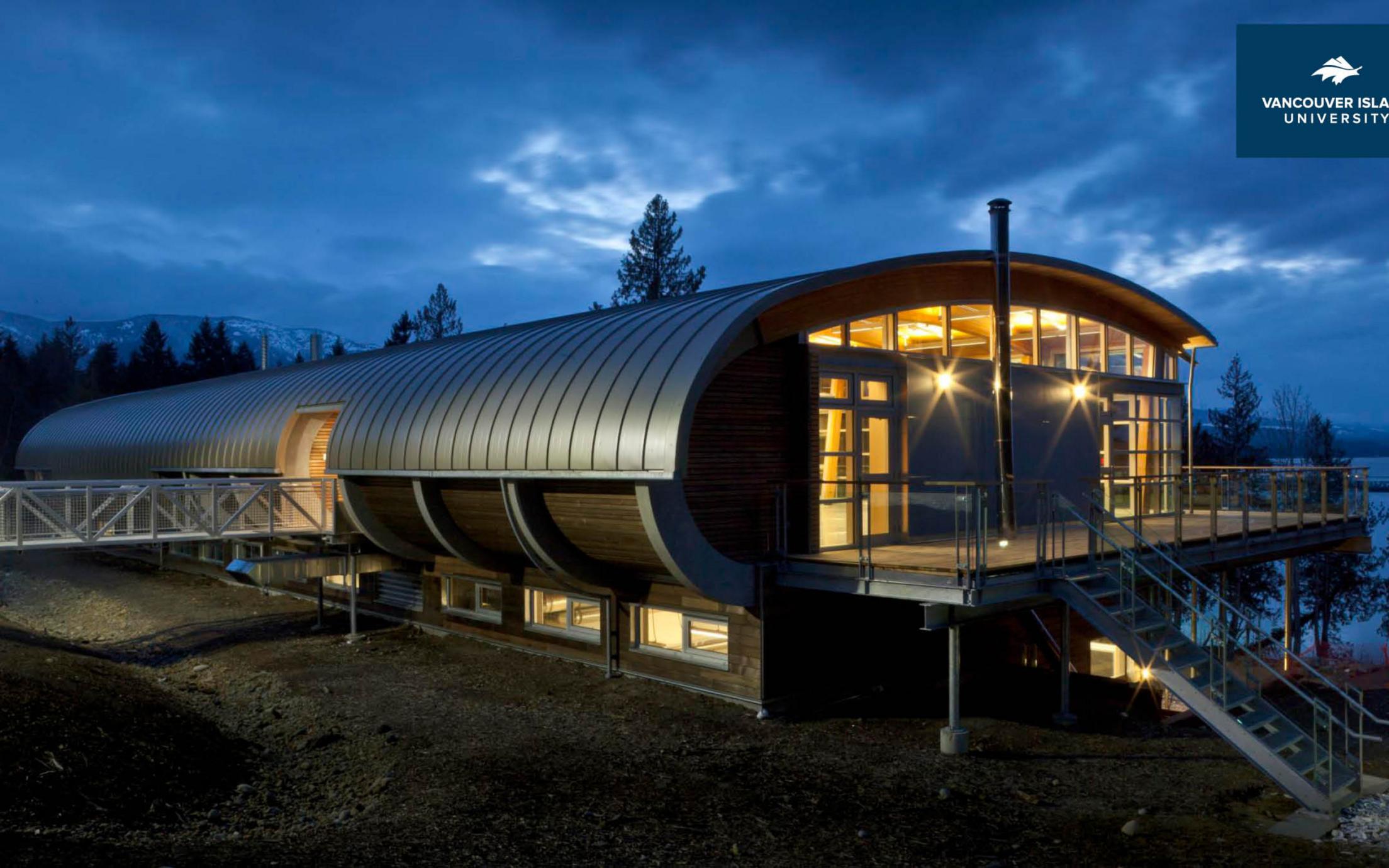Final Report: Monitoring of Drift Seaweed and Harvest in Central Strait of Georgia 2014-15
We have released our final report on studying the drift seaweed and its harvest south of Deep Bay last winter! You can download the final report prepared for the BC Ministry of Agriculture at this link: VIUCSR Beach Wrack Monitoring 2014-15 Final Report. If you are interested in this issue we urge you to please download the full report. The Executive Summary from the report follows below the jump. We anticipate that we will hold a community reporting session at the Field Station this summer to present the research of ourselves and others.
Executive Summary
Background
At the request of the BC Ministry of Agriculture, the Centre for Shellfish Research at Vancouver Island University (CSR-VIU) has documented the distribution and characteristics of beach wrack and the harvest activities during the 2014/15 harvest season. The goal of this project was to provide information that will help managers, community and harvesters assess the local environmental effects of this activity.
Since 2007, the British Columbia Ministry of Agriculture (BCMoA) has been issuing licenses that permitted commercial operators to remove beach-cast seaweed from beaches between Deep Bay and Bowser, on the central east coast of Vancouver Island. The target species is the non-native red algae Mazzaella japonica (MJ) . MJ is a valuable source of carrageenans widely used to gel, thicken and stabilize processed foods, cosmetics and pharmaceuticals. Harvests are conducted by hand, using pitchforks to skim beach-cast seaweeds from the supratidal and intertidal zones of beaches within the harvest region. The seaweed is transported from the beach by tracked vehicle and then by truck to local drying facilities for processing. Bales of the dried seaweed are exported for industrial use. In the last few years a group of local residents have voiced concern about the harvest citing environmental and social issues. Many others in the community seem to be neutral or in favour of the harvest for its economic benefits as long as it is sustainable.
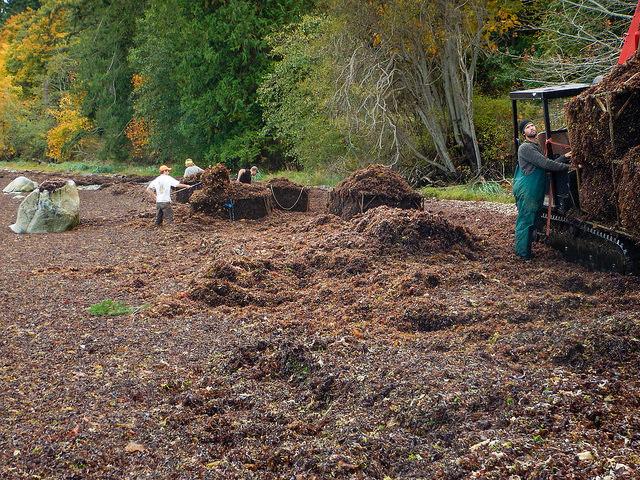
MJ is native to Korea, Japan, and Russia. This species was first recognized in our marine flora about 10 years ago although it may well have been here much longer than that. Reports of distribution have been concentrated in the area south from Deep Bay, south along the east coast of central Vancouver Island.
Detached macroalgae provide a significant spatial subsidy, transferred from marine to coastal and terrestrial ecosystems by oceanic currents, winds, tides and surf. Accumulations of these beach-cast seaweeds and other matter, collectively known as wrack, play an important and well documented role within the marine-terrestrial ecotone. The actual influence of wrack on community dynamics and ecosystem functioning, however, can vary greatly depending on its quantity, distribution and composition.
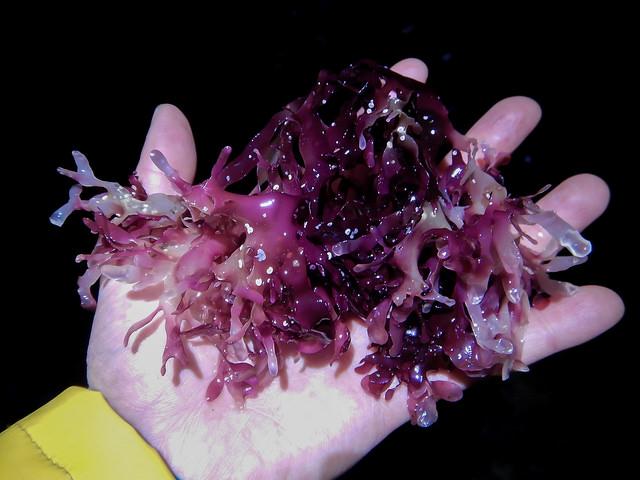
The removal of beach-cast seaweeds, for aesthetic or commercial purposes is increasing globally. Beac h-cast seaweeds are also collected from coastlines world-wide for use in agricultural fertilizers, shellfish aquaculture and for human consumption. Literature on the impacts of harvesting beach-cast seaweed is limited. It is also important to note that other wrack studies should also be considered in light of seasonal and habitat differences.
The objectives of the project were to assess the biomass, distribution and composition of beach wrack accumulations in the MJ licensed harvest area south of Deep Bay, on the East coast of Vancouver Island British Columbia. Specific objectives of the project were as follows:
- Collate existing information on beach wrack monitoring methods and the nature of wrack accumulations in Deep Bay to design an effective study based on international examples as well as local knowledge.
- Quantify the biomass and distribution of beach-cast seaweeds present within the harvest region over the course of the harvesting season.
- Provide a quantitative description of beach wrack macrophyte composition and biomass for harvested sites and un-harvested sites across the region.
- Provide a preliminary description of the fate of beach-cast MJ within the harvest region.
The study area is located on the east coast of Vancouver Island and encompassed the marine foreshore licensed for harvest by the BC Ministry of Agriculture for seaweed harvesting in 2014/15. This area extends along the approximately 4.24 km. The area upland of the harvest/survey area is known as the communities of Deep Bay and Bowser (Regional District of Nanaimo).
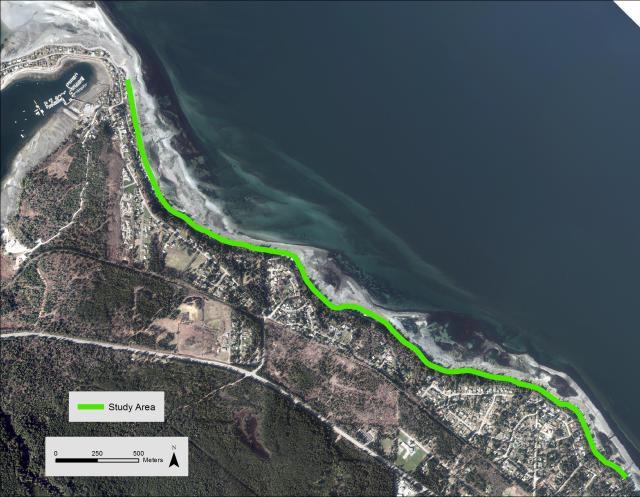
Methods
External data collection included weather event data obtained from the Department of Fisheries and Oceans website. Harvest data was obtained directly from the license holders. In order to quantify the biomass and distribution of beach-cast seaweeds present within the harvest region over the course of the harvesting season the entirety of the harvest region was walked weekly until February 5th, and bi-monthly after the harvest was finished. At randomly established locations along the walk samples were taken including location, number of discrete wrack bands as defined by age classes, depths and percent covers and average weights per volume. Photographs were taken at all sampling stations to document possible changes in the environment over the study period. From the data collected, the volume of wrack was calculated, and the weight of wrack present in the study area was estimated. The volume data are presented through ArcGIS map layouts in order to be more easily visualized.
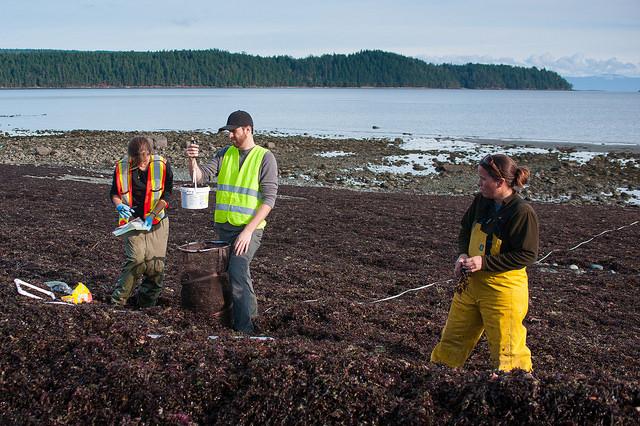
Three permanent transects were established at six sites across the harvest region and monitored weekly to examine the biomass, distribution and macrophyte composition to provide a quantitative description of beach wrack band properties and macrophyte composition for harvested sites and un-harvested comparison sites over the harvesting season and beyond. Quadrat sampling was conducted on a weekly basis and representative samples of wrack were taken. Laboratory analyses of wrack samples included sorting of individual species of macrophytes. Macrofauna were also sorted and retained for future analysis. Species richness and diversity was calculated from these samples.
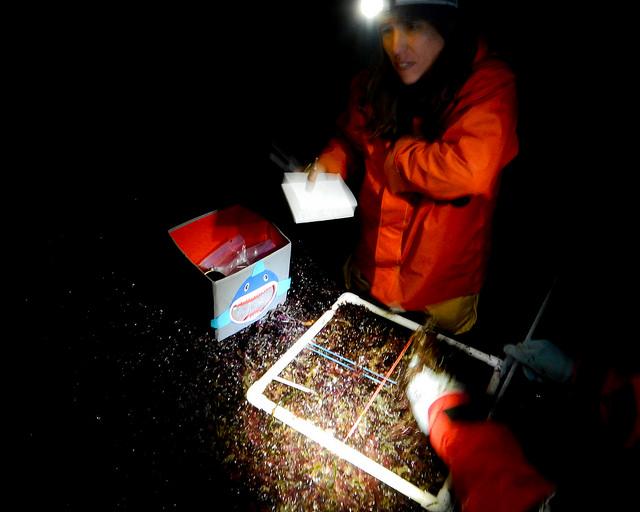
Two drift studies over the course of the monitoring period were conducted to provide a preliminary description of the fate of beach-cast MJ within the harvest region. Bundles of MJ were released on two occasions during the monitoring period. Individual bundles were composed of one naturally-formed bunch of MJ tied and labelled with a 10 cm long piece of highly visible, non-toxic, biodegradable flagging tape.
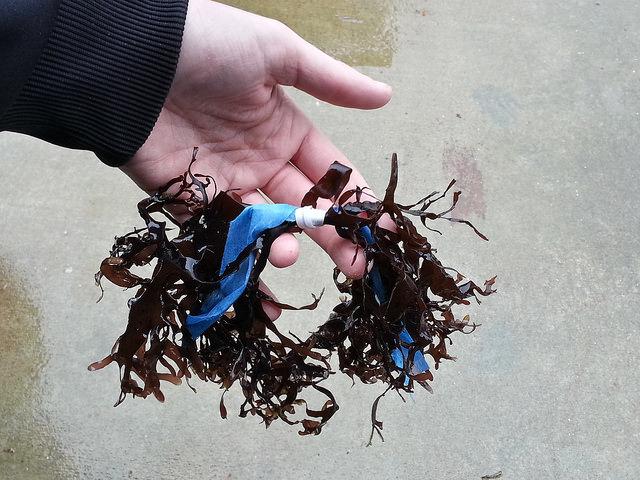
Opportunistic observations and photographs were recorded while in the field including sightings of birds and mammals, public interactions, vehicle tracks, disturbed vegetation and fauna etc. We maintained an active communications policy in response to public and media enquiries during the project.
Results
Winds greater than the 68th percentile of all wind data were chosen to indicate “significant” events which were more than 21.6 knots sustained. Data indicated that there are two predominant winter wind regimes: South –-South-West, typically less than 10 knots and a wind that ranges from East-South-East through to South-East that created winds greater than the significant event threshold.
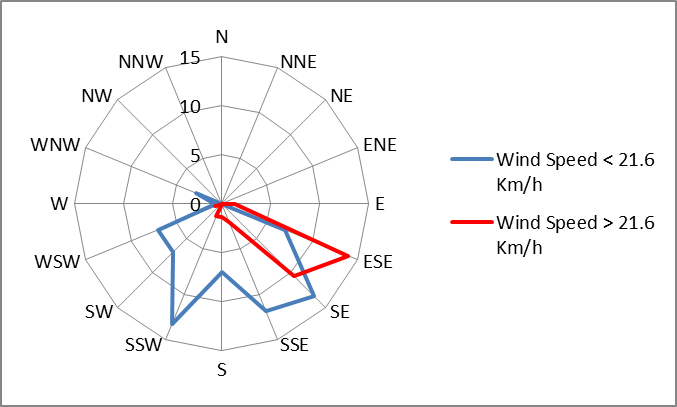
Wind Speed and Bearing over the study period (Oct. 1, 2014 to Feb. 22, 2015)
Harvest data was provided by the three licensed companies. Harvesting began primarily at the Shoreline Drive location and then the majority shifted to The Deep Bay RV Park where the bulk of product was collected. In total 675 tonnes of the 900 tonne quota were harvested between October 5 and January 9 when harvesting ended. Deteriorating quality of beach-cast seaweeds was the reason that harvesters stated for discontinuing harvest activities.
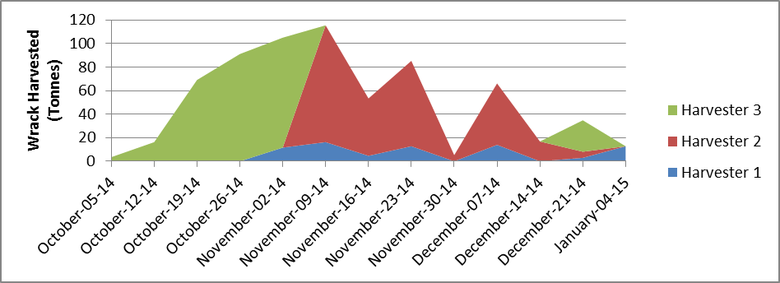
Weekly harvests during season
Biomass sampling began November 7 and was carried out on a weekly basis until Thursday February 22, two weeks after the harvest was scheduled to end. The maximum volume of wrack (1268 tonnes) was noted on the first day of sampling on October 26. This decreased rapidly to an estimated 587 and 608 tonnes during the following two weeks. Survey biomass averaged 212 tonnes per week through January 15th after which estimates dropped below 100 tonnes. Changes in the percent composition of wrack by relative age class indicated that fresh MJ wrack primarily came ashore during November with smaller events during January. Fresh wrack was gone by February which coincided with the cessation in harvesting activities by licensees. At the end of the sampling period total volume had decreased markedly and wrack “aging in place” was largely that which was in the supratidal region above normal high tide.
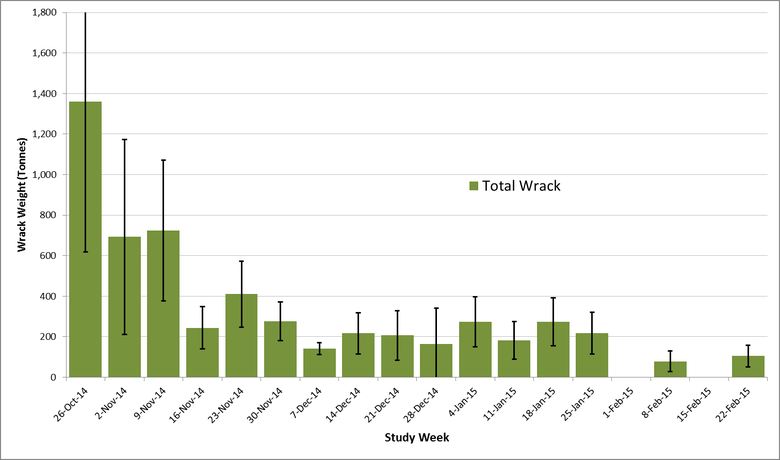
Total wrack biomass estimate by sampling week.
All of the six permanent transect sites experienced different levels of harvesting activity over the course of the 2014-15 harvesting season. Despite the removal of beach-cast seaweeds at the RV Park site throughout the monitoring period, the interquartile range and median biomass values for this site were similar to those of the un-harvested comparison sites suggesting that the harvesting activities were not reducing the available biomass between sites. Wrack biomass generally declined over time for all six sites. The rapid decline in biomass at observed at the RV Park harvest and control sites began in the last two weeks of December, and first week of January. Declines in wrack biomass at RV Harvest transect coinciding with increasing biomass at RV Control transect may suggest the northward-movement of wrack through longshore drift. Biomass was consistently low at the southern sites during the monitoring period.
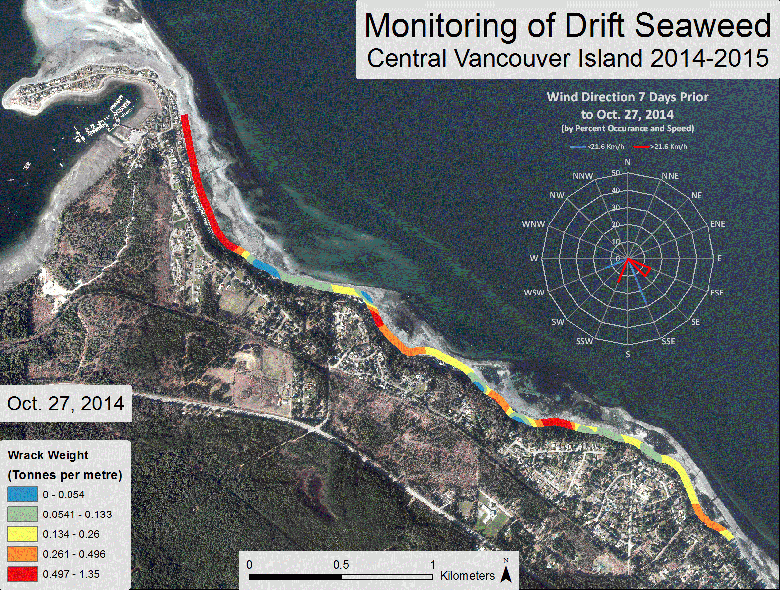
Animation of changes in wrack biomass across study area.
Macrophyte composition was analyzed for samples from 4 of the 15 collection dates. MJ accounted for the greatest proportion of the wrack macrophyte composition at all six of the sites. The proportion of degraded macroalgae (“Unidentifiable”) was greatest at sites with higher wrack biomass. The mean proportion of degraded macroalgae in samples generally increased over the course of the monitoring period, suggesting that the proportion of fresh beach-cast materials was decreasing. The majority of the samples, however, were still primarily composed of identifiable specimens, suggesting that much of the decomposing macroalgae was either being mixed or moving, rather than entirely degrading in place. There was no evidence of spatial trends in total species richness from Southern-most to Northern-most sites, nor with harvesting pressure.
All macrofauna found in wrack samples analyzed for macrophyte composition were removed and stored for later analysis. Macrofauna samples collected in the fall appeared to have fewer specimens while greater activity was observed in the wrack as ambient temperatures rose near the end of winter leading up to spring. Our observations suggest that wrack provides a t dynamic, habitat for macrofauna within the harvest region.
The results of the dispersal study indicate that storm-cast MJ within the supratidal zone can remain there for several weeks or even months, decomposing in place. All bundles placed within the intertidal zone, on the other hand, moved off the beach within a week. Rather than decomposing in place, wrack within this zone appears to be highly mobile. Storm-cast seaweeds within the supratidal and wrack deposits in the intertidal zone therefore have very different fates and unique ecological roles.
During the study period it was impressed upon the study team just how physically dynamic an environment the study area is with significant volumes of sediments, rock up to large boulders shifting through natural processes of wave movement, scour and longshore drift. We noted that in the mid to high intertidal that surface sediments could change from predominantly sand to large cobble to mixed gravels throughout the winter and that the slope and elevation of the beach could change significantly based on the frequency and strength of wave and tidal processes.
Photographs of wrack accumulations taken through the study illustrated rapid decreases in wrack volume that were observed independent of harvest volumes from the study area. Significant volumes of wrack were not observed in the later age classes of decomposition and additionally any long term impacts of the wrack build-up or harvest activities were not visible after wrack volumes decreased.
Anthropogenic changes to substrates as a result of harvesting activity appeared to be restricted to track depressions in soft and gravel sediments in the upper intertidal. These track depressions were not permanent and typically disappeared after the next series of high tides. The study area is primarily composed of upland subdivision settlement. A number of anthropogenic impacts on the study area were noted although the significance of these activities on the near shore environment has not been established. These included the removal of other intertidal plants by upland residents, “protest gardens” and extensive hardening of the upper intertidal. While formal survey protocols for wildlife were not employed, our observations suggest that there is little wildlife interaction with the wrack distributions.
Summary
A summary of the events during the harvest period are shown in the following figure. In this figure the harvest tonnage from the week prior is shown immediately below the volume estimate conducted at the end of the week. The total height of the area graph represents the estimated total biomass (harvested and remaining) during each week of the study (left axis).

Figure: Summary of wrack harvest, mean beach biomass estimate and mean wind speed over study period.
Average sustained wind speed during the week is plotted on the right axis of the graph. A clear relationship can be observed between storm events and increases in wrack volume.
It is important to note that the first biomass sampling estimate was completed on November 7, approximately three weeks after the start of harvesting activities. As a result, the onset of significant wrack biomass accumulating in the study and the total biomass prior to the start of the project is not known. The wind data suggests that the storm events during the middle of October may have brought the largest biomass observed during the season ashore.
Throughout the study period during the active harvest period, the amount of wrack removed ranged from 2-47% of the available biomass with an average of 16.5% (stdev +/- 0.12%) on a weekly basis. The maximum estimate of wrack in the study area was on October 26 with 1268 tonnes estimated by volume + 91 tonnes harvested or approximately 6.7% of total biomass. The next week volume dropped by 667 tonnes although only 101 tonnes (15.2 %) was removed by harvesters. The missing 562 tonnes cannot be accounted for by possible sampling error estimates during biomass surveys.
By November 30th, an estimated 544 tonnes had been removed by harvesters without exceeding more than 21.8 % of the total biomass calculated to be present in the study area in any given week. The following week, an estimated 46.6% of the weekly biomass was removed after which the harvest rate did not exceed 17% of weekly biomass for the rest of the harvest season. Both the biomass survey data and the results of the permanent transects suggest that harvesting does not appear to have a detectable effect on MJ biomass or macrophyte diversity over the course of this study.
Based on the data collected and ancillary observations, it appears that it is simplistic to interpret that wrack is coming ashore during storm events and then being harvested, eaten by macrofauna or decomposing in place as has been previously suggested.
Our working hypothesis is that wrack that remains below the high tide is continually moved northwest by a process of longshore drift, although it may temporarily accumulate in very high volumes in areas such as fronting the RV park. Only small amounts of wrack that is deposited onto the very high tide or above the high tide (supratidal) remains in place and decomposes fully. If this hypothesis is true, beach-cast MJ is brought ashore by wind events in the fall when the plants are weakened due to reproductive stress or other factors. Normal sediment processes of longshore drift in the intertidal rapidly move accumulations of wrack through the study area with rates determined by the combination of wave action and tidal heights. This has significant implications on the understanding of the role of MJ in the local ecosystem and its harvest management. Firstly, it would suggest that the instantaneous biomass estimates calculated on a weekly basis could grossly underestimate the total biomass coming ashore or moving through the 4.2 km harvest area. Secondly, this could mean that the ultimate fate of the MJ might have a significant subtidal component in the deeper portions of Baynes Sound with undetermined consequences on benthos and fauna.
Currently, we do not know how valuable MJ is to the function of this ecosystem; therefore it is not possible to determine if the impact of its removal is positive or negative. Regardless, this study suggests that the amount of seaweed removed is small relative to the amount that accumulates over the winter season. Most other wrack studies have focussed on wrack that has entered the intertidal during summer seasons when productivity is higher and supports larger infaunal and macrofaunal abundances (positive effects) but also potentially negative effects of decomposition. The local situation with MJ may be unique, occurring when temperatures and productivity is low and essentially dissipating out of the study area before biological productivity in the spring increases. A review of nutrient loading in the Strait of Georgia leads us to believe that the removal of MJ from the marine environment would not have a negative impact (limiting production) or significant positive impact (removal of excess anthropogenic nutrient inputs).
MJ has been present in our coastal ecosystems for a long period of time, potentially decades. It is unclear what has caused the perceived increase in abundance over the past decade and evidence is increasing that this species may be invasive. Exploring the drivers behind the localized increased abundance of this species would be valuable for understanding the impacts of this invasion, predicting how it may change in the future and if/how it may spread.
Recommendations
We recommend that further study is required including: continued monitoring of beach cast seaweed and harvests; determination of wrack transport patterns and final fate, the distribution changes of the population including a comparison sites along a gradient of MJ; the community structure of macrofauna within the wrack; further processing of samples taken during this study; interactions with forage fish spawning and; further genetic barcoding to differentiate with native species.

